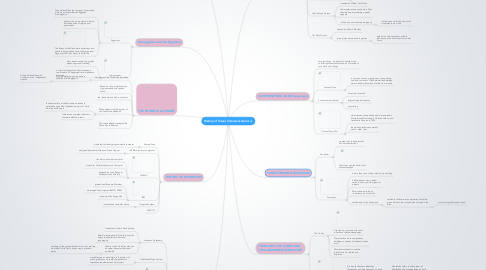
1. Hieroglyphics and the Egyptians
1.1. Egyptions
1.1.1. They believed that the concept of expressing words in writing influenced Egyptian hieroglyphics
1.1.2. believed it was important to record information about religion and government
1.1.3. The Books of the Dead were instructions and spells to help pharoahs and other important Egyptions find their way to the afterlife
1.2. Hieroglyphics
1.2.1. hiero means sacred and glyphic means engraved or writing
1.2.2. a formal writing system that contained a combination of logographic and alphabetic elements
2. THE PHONETIC ALPHABET
2.1. The origin of the Phoenician alphabet
2.1.1. Scholars believed it to be a direct variation of hieroglyphics
2.1.1.1. Others believed ties with Cuneiform or an independent creation
2.2. Based on the principle that one sign represents one spoken sound
2.3. the letters started with consonants
2.4. What helped with the success of the Phoenician alphabet?
2.4.1. the trade culture of the Phoenician merchants spread the use of the alphabet into parts of North America and Europe
2.4.2. It didn't use complex characters that were difficult to learn
2.5. The Greek alphabet adapted the Phoenician letterforms
3. THE GUTENBERG PRESS
3.1. Johannes Gutenberg
3.1.1. introduced modern book printing
3.1.2. After Gutenberg and his family moved, he began to experiment with metal typography
3.1.3. liked to watch his father, who was an upper class merchant and goldsmith
3.1.3.1. watching all the goldsmiths and his love of reading motivated him to find a better way to produce books
3.2. The Movable Type System
3.2.1. movable type, or metal type, is the system of printing that uses movable components to reproduce the elements of a document
3.3. The printing press
3.3.1. is a hand press which ink was rolled over the raised surface of movable hand set letters held within a wooden form
3.4. 4 major printing processes still used today
3.4.1. relief printing
3.4.1.1. oldest method of printing
3.4.2. intaglio
3.4.2.1. (printmaking) image area is etched into the plate surface to hold the ink
3.4.3. porous
3.4.3.1. a basic stencil process
3.4.4. lithography
3.4.4.1. (or planographic) is printing from a flat surface
4. LINOTYPE MACHINE
4.1. Christopher Sholes
4.1.1. invented the only typewriter that became commercially succesful
4.1.1.1. stenographers were the most important people to use his typewriter
4.1.1.2. Clephane tested his typewriter
4.2. Linotype keyboard
4.2.1. It has 90 characters with no shift key
4.2.1.1. Blue keys
4.2.1.1.1. for punctuation, digits, small capital letters and fixed width space
4.2.1.2. Black keys
4.2.1.2.1. for lowercase letters
4.2.1.3. White keys
4.2.1.3.1. for uppercase letters
5. HISTORY OF COMPUTERS
5.1. Konrad Zuse
5.1.1. made the first freely programmable computer
5.2. the Mark series of computers
5.2.1. designed by Howard Aiken and Grace Hopper
5.3. UNIVAC
5.3.1. the first commercial computer
5.3.2. stands for Universal Automatic Computer
5.3.3. designed by John Preseper Eckert and John Mruchly
5.4. IBM
5.4.1. International Business Machines
5.4.2. developed the computer IBM701 EOPM
5.4.3. introduced the floppy disk
5.5. Douglas Englbart
5.5.1. invented the computer mouse
5.6. MS-DOS
6. CAVE PAINTINGS (30,000 years ago)
6.1. cave paintings: are beautiful, detailed, and colorful representations found on the inside of cave walls and ceilings
6.2. Lascaux Cave
6.2.1. in Lascaux, France; most famous cave painting site; had to close in 1963 because the paintings were ruined by the carbon dioxide from tourists
6.3. 3 reasons why created
6.3.1. instructural visual aid
6.3.2. religious/magical reasons
6.3.3. story telling
6.4. Chauvet Pont d’Arc
6.4.1. oldest known cave painting site; discovered by Eliette Brunell Deschamps, Christian Hillaire, and Jean Marie Chauvet in 1994
6.4.2. the painting techniques weren't seen in other sites
7. CUNEIFORM AND SUMERIANS
7.1. Cuneiform
7.1.1. created to help keep track of business transactions
7.1.2. Cuneiform was the worlds first written language
7.2. Sumerians
7.2.1. have a theocratic culture ruled by a priest king
7.2.2. Skilled artisans who created vases, bowls, and other types of pottery
7.2.3. Music seemed to be an important part of their life
7.2.4. settlements of the Sumerians
7.2.4.1. settled in the Sumer area because of its fertile ground due to the many bodies of water in the area
7.2.4.1.1. practiced agriculture year round
8. THE BOOKS: THE CODEX AND THE ILLUMINATED MANUSCRIPT
8.1. The Codex
8.1.1. A codex is a covered and bound collection of handwritten pages
8.1.2. The codex has more compactness, sturdiness, and ease of reference than a scroll
8.1.3. Churches continued to use the codex format for bibles and scriptures
8.2. The Illuminated manuscript
8.2.1. Are books that have elaborate illustrations and ornamentation on each page
8.2.1.1. illumination refers to the borders of illustrations and ornamentation on each page
8.2.2. Reserved for religious text because the work was laborious
9. HISTORY OF PHOTOGRAPHY
9.1. Camera Obscura
9.1.1. an optical device that projects an image of its surroundings onto a screen
9.1.2. the camera obscura room in the 1500s was a darkened room with a convex lens inserted into the wall
9.2. Photography
9.2.1. comes from the Greek words for light and writing
9.3. The First Practical Photographic Process
9.3.1. invented by Louis Daquerre
9.3.2. this process was the Daquerreotype
9.3.2.1. the image was exposed to a light- sensitive metal sheet and the exposure time reduced to half an hour; then he put the image in salt to make it last longer
9.4. the Calotype Process
9.4.1. invented by William Fox Talbot
9.4.2. the image was exposed onto a light sensitive paper producing a paper negative
9.4.3. is the basis of modern photography
9.4.3.1. it allowed an unlimited amount of duplicates to be made
9.5. Dry Plate Process
9.5.1. created by Richard Maddox
9.5.2. glass plates were placed in gelatin
9.5.2.1. gelatin is a colorless water- soluble glutinous protein obtained from animal tissue
